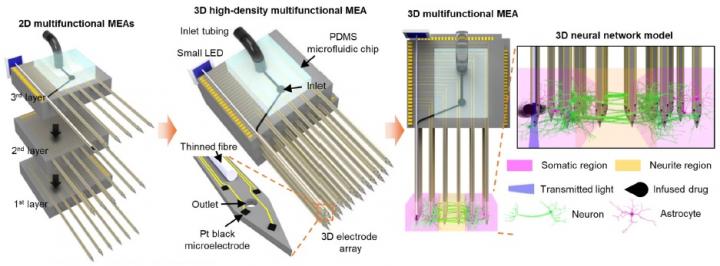Overcoming technological limitations that only allow measurement of 2D neural signals; providing a new method of assessing treatments for brain diseases by applying the method to human cell-based artificial brain models

Credit: Korea Institute of Science and Technology(KIST)
The human brain is less accessible than other organs because it is covered by a thick, hard skull. As a result, researches have been limited to low-resolution imaging or analysis of brain signals measured outside the skull. This has proved to be a major hindrance in brain research, including research on the different developmental stages, causes of diseases, and their treatments. Recently, studies have been performed using primary neurons from rats or human-derived *induced pluripotent stem cells (iPSCs) to create artificial brain models that have been applied to investigate brain developmental processes and the causes of brain diseases. These studies are expected to play a key role to unlocking the mysteries of the brain.
* iPSCs are stem cells made capable of differentiating into diverse organs, like embryonic stem cells, by injecting differentiation-inducing proteins into somatic cells, such as adult skin cells.
In the past, artificial brain models were created and studied in 2D; however, in 2017, a research team from KIST developed a 3D artificial brain model that more closely resembled the real brain. Unfortunately, due to the absence of an analytical framework for studying signals in a 3D brain model, studies were limited to analyses of surface signals or had to reform the 3D structure to a flat shape. As such, tracking neural signals in a complex, interconnected artificial network remained a challenge.
The Korea Institute of Science and Technology (KIST) announced that the research teams of Doctors Il-Joo Cho and Nakwon Choi have developed a analysis system that can apply precise non-destructive stimuli to a 3D artificial neural circuit and measure neural signals in real-time from multiple locations inside the model at the cellular level.
The 3D multifunctional system for measuring neural signals is in the form of a 50μm-wide needel shaped silicon probe array (about half the width of a human hair) integrated with 63 microelectrodes. When this system is inserted in the artificial brain model, it is capable of simultaneously measuring signals from multiple locations inside the neural circuit. The probe contains an optical fiber and drug-delivery channels, enabling precise stimulation of neurons using light or drugs. By measuring functional changes in the brain model in response to these stimuli, the model can be used to study brain function and brain diseases.
Using this system to stimulate neural circuits in the artificial brain model optically and simultaneously measure the spread of the response signal in multiple locations, the research team demonstrated that the propagation speed of neural signals were different according to directions inside the 3D brain modeln. In addition to **structural brain maps, which can be constructed using electron microscopy, this study demonstrated the possibility of constructing 3D ***functional brain maps that show how different circuits are functionally connected within complex artificial brain networks.
**Structural brain map: A map showing the physical connections between brain cells or brain regions.
***Functional brain map: A map showing the connections between neurons or regions that exchange signals to perform specific brain functions.
Dr. Choi, from KIST, stated that, “The newly developed system allows us to study various developmental brain disorders and the causes of and treatments for brain diseases.” Co-PI Dr. Cho added, “This system enables functional measurements from 3D artificial brain models, which was previously impossible. We expect that the development of this system will help to radically reduce the time required to develop drug or treatments for various brain diseases.”
###
This research was conducted as a part of KIST Institutional research program and the Brain Convergence Research Program of the National Research Foundation, funded by the Ministry of Science and ICT (MSIT). The findings was published in the latest issue of ‘Nature Communications‘ (IF: 12.121).
Media Contact
Do-Hyun Kim
[email protected]
Related Journal Article
http://dx.




